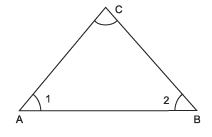Class 9 Maths Question Answers - Triangles
Q.1. In a ΔABC, BC = CA and ∠ A = 50°, which is longer BC or AB?
Sol. ∵ ∠ 1 = ∠ 2 [∵ AC = BC]
and ∠A = ∠1 = 50°
 ⇒ ∠ 2 = 50°
⇒ ∠ 2 = 50°
⇒ ∠1+ ∠2+ ∠3= 180 [ angle sum property ]
∴ ∠ C = 180º - [50° + 50°] = 80°
⇒ Since, ∠C > ∠A
⇒ AB > BC Thus, AB is greater. [The greatest side is opp. to the greatest angle.]
Q.2. In ΔABC, ∠ B = 60° and ∠ C = 63°. Name the greatest side.
Sol. In ΔABC, ∠ B = 60° and ∠ C = 63°
 ⇒ ∠A+ ∠B+ ∠C= 180 [ angle sum property ]
⇒ ∠A+ ∠B+ ∠C= 180 [ angle sum property ]
⇒ ∠ A = 180º - (60° + 63°) = 57°
⇒ The greatest side is opp. to the greatest angle, i.e., 63°
∴ Side AB is the greatest.
Q.3. In ΔABC, if BC = AB and ∠ B = 80°, then find the measure of∠ A.
Sol. BC = AB ⇒ ∠A = ∠C

⇒ ∠A+ ∠B+ ∠C= 180 [ angle sum property ]
∵ ∠B = 80°
∴ ∠A + ∠C = 180° - 80° = 100°
⇒ ∠A = ∠C = 50º
Q.4. Which of the following is not the criterion for congruence of triangles?
(i) SAS (ii) SSA (iii) ASA (iv) RHS
Ans: SSA is not the criterion for congruency.
Q.5. If two angles are (30 - a)º and (125 + 2a)º and they are supplement of each other. Find the value of ‘a’.
Sol. ∵ (30 - a)º and (125 + 2a)º are supplement to each other.
∴ (30 - a + 125 + 2a)º = 180º
⇒ a = 180º - 125º - 30º = 25º
⇒ Value of a = 25°
Q.6. Each of the equal angles of an isosceles triangle is 38°. What is the measure of the third angle?
Sol. Let the third angle = x
∴ x + 38° + 38° = 180°
⇒ x = 180° - 38° - 38° = 104º
Q.7. In an isosceles ΔABC, AB = AC and ∠ A= 80°. What is the measure of ∠ B?
Sol. We have AB = AC ⇒ ∠ B = ∠ C [∵ Angles opposite to equal sides are equal]
∴ ∠A + ∠B + ∠C = 180°
⇒ ∠A + ∠B + ∠B = 180°
⇒ ∠A + 2∠B = 180°
⇒ 80° + 2∠B = 180°
⇒ 2∠B = 180°- 80°
= 100
⇒ ∠B= (100o/2) = 50°
Q.8. Find the measure of each acute angle in a right angle isosceles triangle.
Sol. Let the measure of each of the equal acute angle of the Δ be x
∴ We have: x + x + 90° = 180°
⇒ x + x = 180° - 90° = 90°
⇒ x= (90o/2)= 45°
|
40 videos|560 docs|57 tests
|
FAQs on Class 9 Maths Question Answers - Triangles
| 1. What are the properties of triangles? |  |
| 2. How do you calculate the area of a triangle? |  |
| 3. What is the difference between acute, obtuse, and right triangles? |  |
| 4. How can you determine if three lengths can form a triangle? |  |
| 5. What are congruent triangles and how can they be proven? |  |

















